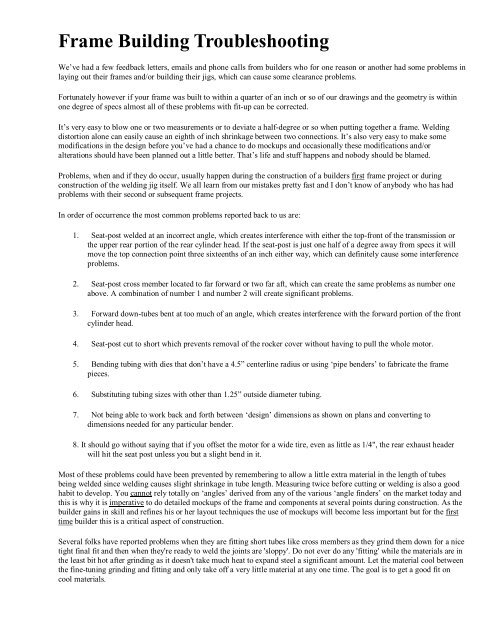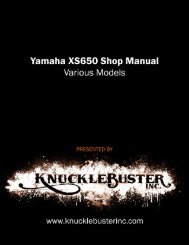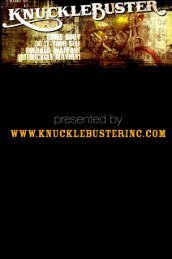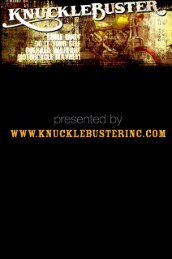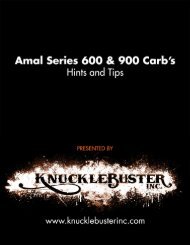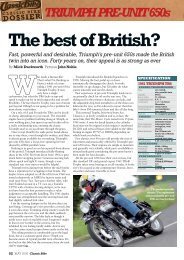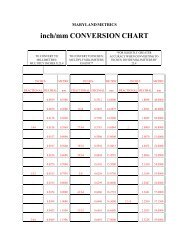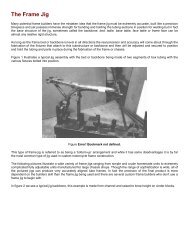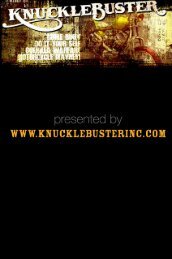Old School Chopper Frame Fabrication - Knucklebuster
Old School Chopper Frame Fabrication - Knucklebuster
Old School Chopper Frame Fabrication - Knucklebuster
You also want an ePaper? Increase the reach of your titles
YUMPU automatically turns print PDFs into web optimized ePapers that Google loves.
<strong>Frame</strong> Building Troubleshooting<br />
We’ve had a few feedback letters, emails and phone calls from builders who for one reason or another had some problems in<br />
laying out their frames and/or building their jigs, which can cause some clearance problems.<br />
Fortunately however if your frame was built to within a quarter of an inch or so of our drawings and the geometry is within<br />
one degree of specs almost all of these problems with fit-up can be corrected.<br />
It’s very easy to blow one or two measurements or to deviate a half-degree or so when putting together a frame. Welding<br />
distortion alone can easily cause an eighth of inch shrinkage between two connections. It’s also very easy to make some<br />
modifications in the design before you’ve had a chance to do mockups and occasionally these modifications and/or<br />
alterations should have been planned out a little better. That’s life and stuff happens and nobody should be blamed.<br />
Problems, when and if they do occur, usually happen during the construction of a builders first frame project or during<br />
construction of the welding jig itself. We all learn from our mistakes pretty fast and I don’t know of anybody who has had<br />
problems with their second or subsequent frame projects.<br />
In order of occurrence the most common problems reported back to us are:<br />
1. Seat-post welded at an incorrect angle, which creates interference with either the top-front of the transmission or<br />
the upper rear portion of the rear cylinder head. If the seat-post is just one half of a degree away from specs it will<br />
move the top connection point three sixteenths of an inch either way, which can definitely cause some interference<br />
problems.<br />
2. Seat-post cross member located to far forward or two far aft, which can create the same problems as number one<br />
above. A combination of number 1 and number 2 will create significant problems.<br />
3. Forward down-tubes bent at too much of an angle, which creates interference with the forward portion of the front<br />
cylinder head.<br />
4. Seat-post cut to short which prevents removal of the rocker cover without having to pull the whole motor.<br />
5. Bending tubing with dies that don’t have a 4.5” centerline radius or using ‘pipe benders’ to fabricate the frame<br />
pieces.<br />
6. Substituting tubing sizes with other than 1.25” outside diameter tubing.<br />
7. Not being able to work back and forth between ‘design’ dimensions as shown on plans and converting to<br />
dimensions needed for any particular bender.<br />
8. It should go without saying that if you offset the motor for a wide tire, even as little as 1/4", the rear exhaust header<br />
will hit the seat post unless you but a slight bend in it.<br />
Most of these problems could have been prevented by remembering to allow a little extra material in the length of tubes<br />
being welded since welding causes slight shrinkage in tube length. Measuring twice before cutting or welding is also a good<br />
habit to develop. You cannot rely totally on ‘angles’ derived from any of the various ‘angle finders’ on the market today and<br />
this is why it is imperative to do detailed mockups of the frame and components at several points during construction. As the<br />
builder gains in skill and refines his or her layout techniques the use of mockups will become less important but for the first<br />
time builder this is a critical aspect of construction.<br />
Several folks have reported problems when they are fitting short tubes like cross members as they grind them down for a nice<br />
tight final fit and then when they're ready to weld the joints are 'sloppy'. Do not ever do any 'fitting' while the materials are in<br />
the least bit hot after grinding as it doesn't take much heat to expand steel a significant amount. Let the material cool between<br />
the fine-tuning grinding and fitting and only take off a very little material at any one time. The goal is to get a good fit on<br />
cool materials.


